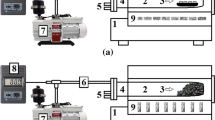Abstract
A new process of producing magnesium by thermal vacuum reduction using dolomite and magnesite as materials and silicocalcium as reductant was studied in this study. The reduction process of MgO by silicocalcium was analyzed by phases analysis of reduction slag through X-ray diffraction (XRD) and the factors influencing the reduction ratio of MgO were investigated. The experimental results show that when using silicocalcium as reductant, the reduction ratio of MgO can be over 93 %. In the reduction process, calcium in silicocalcium takes part in the reduction reaction of MgO firstly below 1,000 °C and it makes CaSi2 decompose. It also releases elemental silicon which has more reactive activity and improves the reduction reaction of MgO. That is the main cause that the reduction ratio of MgO using silicocalcium as reductant is 8 %–10 % higher than that by Pidgeon process using ferrosilicon as reductant under the same conditions.







Similar content being viewed by others
References
Gao F, Nie ZR, Wang ZH, Gong XZ, Zuo TY. Life cycle assessment of primary magnesium production using the Pidgeon process in China. Int J Life Cycle Assess. 2009;14(5):480.
Minic D, Manasijevic D, Jelena D. Silicothermic reduction process in magnesium production. J Therm Anal Calorim. 2008;93(2):411.
Francesco C, Marco RB, Sergio U. LCA of magnesium production technological overview and worldwide estimation of environmental burdens. Resour Conserv Recycl. 2008;52(7):1093.
Ramakrishnan S, Koltun P. Global warming impact of the magnesium produced in China using the Pidgeon process. Resour Conserv Recycl. 2004;42(1):49.
Gao F, Nie ZR, Wang ZH, Zuo TY. Resource depletion and environmental impact analysis of magnesium produced using Pidgeon process in China. Chin J Nonferrous Metals. 2006;16(8):1456.
Li J, Wang J, Zhang B, Dong DM, Fang CS. Evaluation method for clean production of magnesium industry with Pidgeon process. Environ Sci Technol. 2009;32(8):176.
Guo QF. Study on influential factors of techno-economic indicator of Pidgeon technology. Light Metals. 1990;9:34.
Zhang MJ, Li JD, Guo QF, Qiu ZX. Study of Pidgeon process production with highly effective reducing agent. Light Metals. 2005;12:39.
Hu WX, Feng NX, Wang YW. Magnesium production by vacuum aluminothemic reduction of a mixture of calcined dolomite and calcined magnesite. The Minerals, Metals & Materials Society Annual Meeting. San Diego. 2011, 43.
Friedrich HE, Mordike BL. Magnesium Technology. Berlin: Springer; 2006. 56.
Guo QF. A method of producing magnesium using aluminum silicon alloy as reductant. Chinese Patent: CN 1246487C, 2006.
Lu ZS. A method of producing magnesium by vacuum aluminothermic reduction. Chinese Patent: CN 1664135A, 2005.
Peng JP, Wu XL, Feng NX. Experimental study on vacuum thermal reduction of ascharite mineral with calcium carbide as reductant. Vacuum Technology and Surface Engineering - Proceeding of the 10th Vacuum Met allurgy and Surface Engineering Conference. Shenyang: 2011. 8.
Xu D, Zhang XP, Li G, Cheng EQ, Shi CH. Research on vacuum thermal reduction of ascharite with calcium carbide as reductant. Ming Metall. 2008;17(2):39.
Xu LM. Principle and technical process of producing silicocalcium. Ferro-alloy. 2008;6:1.
Wang YW, Feng NX, You J, Hu WX. Study on the effect of CaF2 addition on the process of vacuum aluminothermic reduction. Chin J Vac Sci Technol. 2012;32(10):889.
Hu WX, Liu J, Feng NX, Peng JP. The effect of villiaumite on magnesium production by Al–Si–Fe alloy thermal reduction of dolomite. Light Metals. 2010;5:42.
Feng NX, Wang YW. A method of producing magnesium by vacuum thermal reduction using a mixture of magnesite and dolomite as materials. Chin J Nonferrous Metals. 2011;21(10):2678.
Acknowledgments
This study was financially supported by the Industrial Research Project of Liaoning Province (No. 2011221002) and the Project of High Technology Plan of Magnesium Materials of Liaoning (No. MYF2011-34).
Author information
Authors and Affiliations
Corresponding author
Rights and permissions
About this article
Cite this article
Wang, YW., Zhao, K., Peng, JP. et al. Process of producing magnesium by thermal vacuum reduction using silicocalcium as reductant. Rare Met. 35, 571–575 (2016). https://doi.org/10.1007/s12598-014-0321-4
Received:
Revised:
Accepted:
Published:
Issue Date:
DOI: https://doi.org/10.1007/s12598-014-0321-4




